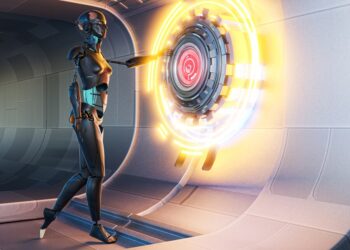The Role of Robotics in Space Exploration: A New Era of Discoveries
Space exploration has always been a fascinating subject, capturing the imagination of people from all walks of life. From the early days of the space race to modern-day space missions, humans have been pushing the boundaries of science and technology to explore the vast expanse beyond our planet. However, space exploration is not without its challenges, particularly in terms of the limitations of human capabilities in the harsh conditions of space. This is where robotics plays a crucial role, providing a way for humans to explore space beyond their physical limits. In this article, we explore the role of robotics in space exploration and how it is shaping the future of space exploration.
The history of robotics in space exploration dates back to the 1960s when NASA first began to develop robotic systems for space missions. One of the earliest examples of robotic exploration was the Ranger series of spacecraft, which were designed to take close-up pictures of the Moon’s surface. Later, in the 1970s, NASA launched the Viking landers to explore the surface of Mars. These landers were equipped with robotic arms that were capable of collecting soil samples and conducting experiments on the Martian surface.
Since then, robotic exploration has come a long way, and robots have become an integral part of space exploration. One of the primary advantages of using robots in space exploration is that they can operate in environments that are hostile to human life, such as the vacuum of space, extreme temperatures, and radiation. Robots can also operate for extended periods of time without the need for rest or life support, allowing for long-term exploration and research missions.

One of the most significant examples of robotic exploration in recent years is the Mars rovers, Spirit, Opportunity, and Curiosity. These rovers are equipped with a range of scientific instruments and cameras, allowing them to explore the Martian surface and conduct experiments. The Mars rovers have made several groundbreaking discoveries, such as evidence of water on Mars, which has led to renewed interest in the search for life beyond Earth.
Another example of robotic exploration is the European Space Agency’s (ESA) Rosetta mission. The Rosetta spacecraft was launched in 2004 and arrived at the comet 67P/Churyumov-Gerasimenko in 2014. The spacecraft was equipped with a lander, Philae, which was designed to land on the surface of the comet and conduct experiments. Although Philae experienced some technical difficulties during its landing, the mission was a success overall, providing valuable data on comets and their composition.
Robots are also being developed for future space missions, such as NASA’s Mars 2020 mission. The Mars 2020 mission will include a new rover, Perseverance, which is equipped with a range of scientific instruments, including a drill that can collect core samples from the Martian surface. The mission will also include a helicopter drone, Ingenuity, which will be the first aircraft to fly on another planet.
In addition to exploration missions, robots are also being developed for space infrastructure and maintenance. The International Space Station (ISS) is a prime example of this, with robots such as the Canadarm2 and Dextre performing a range of tasks, such as capturing and berthing spacecraft, performing repairs, and conducting experiments.
The use of robotics in space exploration has several advantages over human exploration. One of the main advantages is safety. Human exploration of space is inherently risky, with dangers such as radiation exposure, decompression sickness, and the possibility of spacecraft malfunctions. Robotic exploration eliminates many of these risks, allowing for safe and efficient exploration of space.
Another advantage of robotic exploration is cost-effectiveness. Human space missions are expensive, with costs ranging in the billions of dollars. Robotic missions, on the other hand, are much more cost-effective, as they do not require life support systems or provisions for human crews. This allows for a greater number of missions to be conducted, leading to a more comprehensive understanding of space.
The use of robots in space exploration also allows for greater flexibility in mission design. Unlike humans, robots do not require food, water, or rest, which means they can operate for extended periods of time without interruption. This allows for missions to be designed around the specific scientific goals, rather than the limitations of human endurance.
Despite the advantages of robotic exploration, there are also some limitations. One of the primary limitations is the lack of human intuition and creativity. Human explorers are able to make on-the-spot decisions and react to unexpected situations, whereas robots are limited to pre-programmed instructions. This can make it difficult for robots to respond to unexpected events or make decisions on their own.
Another limitation of robotic exploration is the limited dexterity of current robotic systems. While robotic arms and manipulators are able to perform some tasks, such as collecting soil samples or conducting experiments, they are not yet able to perform tasks that require fine motor skills or delicate manipulation. This limits the range of experiments and tasks that can be conducted by robots.
Despite these limitations, the role of robotics in space exploration is set to grow in the coming years. Advances in artificial intelligence and machine learning are enabling robots to become more autonomous and capable of decision-making, which could overcome some of the limitations of current robotic systems. Additionally, the development of new materials and technologies is leading to the creation of more advanced robotic systems, such as soft robots that are more flexible and adaptable.

Conclusion
The role of robotics in space exploration is becoming increasingly important as we continue to explore the vast expanse beyond our planet. Robots provide a way for humans to explore and conduct research in environments that are hostile to human life, while also offering greater safety, cost-effectiveness, and flexibility in mission design. While there are limitations to current robotic systems, advances in technology are paving the way for more advanced and capable robots in the future. As we continue to push the boundaries of space exploration, robots will undoubtedly play a crucial role in our quest for new discoveries and a greater understanding of our place in the universe.
















